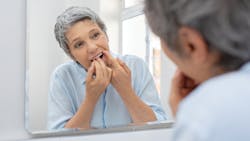Senior care: The importance of oral health for overall health
If there were ever a period in history to grow old, now is it. Around the world, due mainly to improved health care, people are living healthier, longer lives than ever before. This, coupled with the fact that people are having fewer children, indicates a global trend toward an aging population.1,2
As we enter this golden era, we must give increased attention to elder care to ensure that longevity goes hand-in-hand with good health. Geriatric medicine specializes in the unique needs and conditions prevalent in older populations, such as strokes and dementia. Dentistry can also have a geriatric focus, as we can expect to see an increase in dental caries, periodontal disease, tooth loss, xerostomia, and oral cancer as our patients age.3
Did you know that there are links between poor oral health and strokes and Alzheimer’s disease?4 Also, in a 2017 review paper regarding improving dental health in elderly patients, the connection was made between poor oral health and “low self-esteem, decreased social interactions, malnutrition, dysphagia, and aspiration pneumonia.”5 This is yet another set of physical, psychological, and social conditions that we may not automatically link to dental hygiene.
To ensure complete health into old age, we advocate for an interprofessional approach to geriatric oral health and existing elder care practices, drawing on our combined expertise in the dental and nursing fields. Better oral health not only contributes to overall well-being, but it can also act as a preventive measure for common conditions among elderly patients. Furthermore, other medical conditions may result in compromised oral health.
Quality of life and oral care
A happy, healthy life should be about overall quality rather than the quantity of years. The medical field recognizes this, with increasing government and health organization-led programs engineered toward improving the quality of life for senior citizens.6 Since poor oral health is associated with several dental and nondental conditions, prevention is often the best solution. It stands to reason that by making sure senior citizens are maintaining adequate dental care, we can help protect them against many other medical issues.
In order to thrive, we must have adequate nutrition. There is a body of research testifying to the link between tooth loss or ill-fitting dentures that affects chewing and the taste of food, which can lead to malnutrition.7,8 Not only do more teeth help with nutrition, but with psychological and social health implications, as teeth help with the forming and pronunciation of words, as well as support facial structure and overall appearance.9
Dry mouth and quality of life
Although there is some conflicting research over how many remaining teeth affect the overall quality of life, studies are in agreement when it comes to xerostomia and quality of life.6 In a 2016 study to evaluate oral health–related quality of life (OHRQoL) across numerous areas that affect older people, the resounding conclusion was dry mouth has the most significant impact on quality of life.6
The most common cause of xerostomia in geriatric patients is polypharmacy. Patients may be taking a number of medications to manage various conditions (in this particular study, participants were taking anywhere from one to 17 different medications). With more than 400 drugs listing xerostomia as a side effect, it is a prevalent issue. Dry mouth can cause problems in both oral tissues and function, including difficulty with chewing, swallowing, speech, and taste, and also increase the chances for dental caries and gingivitis.
What is most striking in the study, however, was the lack of patient knowledge regarding the treatment of xerostomia. Only a handful of study participants used specific medication or toothpaste to target xerostomia; some drank water; and 20% took no measures at all to correct the problem.
Doctors and medical professionals prescribe these medications, yet it is dentists who see their effects on the oral tissues, which can cause a myriad of further physical issues. It’s a vicious cycle between the medical and dental worlds. In these instances, an interprofessional approach could create a world of difference. All it requires is adequate education for patients and caregivers about xerostomia as a side effect of polypharmacy and its potential oral-systemic effects.
Tooth loss, pain, and dementia
Some may think that the impact of tooth loss is simply esthetic, leading to decreased self-confidence. However, tooth loss disrupts the vertical dimension of the jaw, which has pathophysiological implications. As well as potentially affecting nutrition, tooth loss can result in a considerable amount of discomfort, which manifests as TMJ disorders, headaches, and orofacial pain. Even broader reaching implications, such as neck and back pain and negative effects on overall posture and balance, can also occur.10–12
Research increasingly corroborates the link between neurodegenerative disorders and tooth loss, particularly in the case of Alzheimer’s disease, where a correlation is found between the oral bacteria Porphyromonas gingivalis and the disease.13,14 There are further implications when it comes to dementia and care of the teeth, as the decrease in a patient’s cognitive function can result in the neglect of dental hygiene or substandard home care.4 This stresses the need for proper oral health care as a preventive measure and again demonstrates the need for adequate education for patients and caregivers from their primary care providers, as well as training on the correlation between oral health and systemic conditions.
The denture debate
It is widespread wisdom in the world of dentistry that dentures should be removed at bedtime for a variety of reasons, including preventing everything from accelerated bone loss to gum inflammation and even aspiration pneumonia.15 Removing dentures at night promotes better dental hygiene through adequate cleaning of the dentures and oral tissues.
However, there is an interesting caveat. A study of edentulous seniors who experience obstructive sleep apnea (OSA) discovered that when wearing complete dentures during sleep, the majority of the patients experienced an improvement in their condition.16 What this study further demonstrates is that there is a greater need for communication between medical and dental professionals with regard to denture-wearing seniors who experience or may be at risk for OSA. Without improved communication, we risk patients being given conflicting information because of an incomplete picture of their health.
The need for an interprofessional approach
Parkinson’s disease, increased risk for strokes, and various forms of musculoskeletal degeneration—such as rheumatoid arthritis, osteoarthritis, and osteoporosis—are also associated with aging. Studies show that individuals who experience these conditions are more likely to have compromised oral health care purely because the resulting restrictions in their movement makes taking care of their teeth more difficult.4
As discussed earlier, a mix of limited mobility, medication, and cognitive impairment affects oral health. It is highly likely that senior citizens—no matter how health-conscious they are—will experience at least one of these conditions, to a lesser or greater degree, as they age. It is a precarious chicken-and-egg situation when it comes to medical and dental health, as a decrease in either can affect the other.
What can be done?
All of these issues and interactions outline the deep need for an interprofessional approach to geriatric patient care. There is strong evidence to suggest a gap in the knowledge and training for caregivers.7,17 If the links between oral, physical, psychological, and social health are not apparent to patients or the caregivers, how can we expect them to give dental hygiene the care it deserves? Additionally, caregivers may feel incapable of providing adequate dental care. We need to make sure that our family member caregivers, nursing, and elder caregiving staff feel confident to carry out these tasks; there is evidence that training protocols have already proven effective.7
What is the responsibility of dental professionals when we treat aging patients in our clinics given that we are aware of the links between oral and medical conditions? One study found that “most of the current older than 60 were not introduced to the concept of preventive dentistry at a young age and thus are not inclined to it.”8
We must work to change this, implementing educational protocols for our older patients. The reality of aging means waning health and a higher risk of tooth loss and inflammation. Having conversations about this with our patients should be the norm. How can we ensure that our dental responsibilities to our patients do not cease when they stop being able to visit our practices? Again, it is essential to educate caregivers and other health professionals in these matters.
It would be appropriate to have a plan for your practice when a patient can no longer visit your office for dental appointments. Implementing technology and using programs such as TeleDent (MouthWatch) to reach patients who cannot reach you is a great way to ensure that they are not left behind. Dental hygienists Sonya Dunbar and Angie Stone are doing a great job reaching patients in long- and short-term-care facilities to bring dentistry to the aging population. They are working with medical providers to make certain these patients have proper dental care.
We may consider it impolite to bring up age with our elders, but as dental, nursing, and medical professionals, we have a bigger responsibility! We need to take these considerations into account to ensure that we can all grow old with the most exceptional level of health possible.
References
1. Ageing. United Nations Population Fund. Updated October 13, 2015. Accessed February 19, 2020. https://www.unfpa.org/ageing
2. Miller CC. Americans are having fewer babies. They told us why. The New York Times. July 5, 2018. Accessed February 19, 2020. https://www.nytimes.com/2018/07/05/upshot/americans-are-having-fewer-babies-they-told-us-why.html
3. Oral health for an ageing population. FDI World Dental Confederation. Accessed February 19, 2020. https://www.fdiworlddental.org/what-we-do/projects/oral-health-for-an-ageing-population
4. Veiga N, Castro A, Mendes J, et al. Oral health and physical and mental limitations among the elderly. Int J Dent Oral Health. 2016;2(6). doi:10.16966/2378-7090.203
5. Rozas NS, Sadowsky JM, Jeter CB. Strategies to improve dental health in elderly patients with cognitive impairment: a systematic review. J Am Dent Assoc. 2017;148(4):236-245.e3. doi:10.1016/j.adaj.2016.12.022
6. Paredes-Rodriguez VM, Torrijos-Gómez G, González-Serrano J, López-Pintor-Muñoz RM, López-Bermejo MA, Hernández-Vallejo G. Quality of life and oral health in elderly. J Clin Exp Dent. 2016;8(5):e590-e596. doi:10.4317/jced.53317
7. Kohli E, Nelson S, Ulrich S, Finch T, Hall K, Schwarz E. Dental care practices and oral health training for professional caregivers in long-term care facilities: an interdisciplinary approach to address oral health disparities. Geriatr Nurs. 2017;38(40):296-301. doi:10.1016/j.gerinurse.2016.11.008
8. Razak PA, Richard KMJ, Thankachan RP, Hafiz KAA, Kumar KN, Sameer KM. Geriatric oral health: a review article. J Int Oral Health. 2014;6(6):110-116.
9. Holmén A, Strömberg E, Hagman-Gustafsson ML, Wårdh I, Gabre P. Oral status in home-dwelling elderly dependent on moderate or substantial supportive care for daily living: prevalence of edentulous subjects, caries and periodontal disease. Gerodontology. 2012;29(2):e503-e511. doi:10.1111/j.1741-2358.2011.00507.x
10. Know Your Teeth Infobites. What is orofacial pain? Academy of General Dentistry. March 18, 2020. Accessed February 20, 2020. http://www.knowyourteeth.com/infobites/abc/article/?abc=P&iid=323&aid=1306
11. How are dental health and back pain connected? The Spine Institute Center for Spinal Restoration. Accessed February 20, 2020. https://www.laspine.com/back-pain-and-teeth/
12. Plataforma SINC. A bad bite is associated with worse postural, balance control. ScienceDaily. September 14, 2016. Accessed February 20, 2020. https://www.sciencedaily.com/releases/2016/09/160914090458.htm
13. Chen J, Ren CJ, Wu L, et al. Tooth loss is associated with increased risk of dementia and with a dose-response relationship. Front Aging Neurosci. 2018;10:415. doi:10.3389/fnagi.2018.00415
14. Oral bacteria may be responsible for Alzheimer’s disease. Harvard University. February 7, 2019. Accessed February 20, 2020. http://sitn.hms.harvard.edu/flash/2019/oral-bacteria-may-responsible-alzheimers-disease/
15. Iinuma T, Arai Y, Abe Y, et al. Denture wearing during sleep doubles the risk of pneumonia in the very elderly. J Dent Res. 2015;94(suppl 3):28S-36S. doi:10.1177/0022034514552493
16. Arisaka H, Sakuraba S, Tamaki K, Watanabe T, Takeda J, Yoshida K. Effects of wearing complete dentures during sleep on the Apnea-Hypopnea Index. Int J Prosthodont. 2009;22(2):173-177.
17. Zuluaga DJM, Ferreira J, Montoya JAG, Willumsen T. Oral health in institutionalised elderly people in Oslo, Norway and its relationship with dependence and cognitive impairment. Gerodontology. 2012;29(2):e420-e426. doi:10.1111/j.1741-2358.2011.00490.x
About the Author

Julia Worrall, RN, CCRN
Julia Worrall, RN, CCRN, also known as the Sleep RN, is a highly sought-after expert in sleep and airway health, connecting what was once thought to be disconnected. She is asked to speak at conferences and high-level meetings and featured on podcasts around the world. As a passionate airway advocate and mentor, Ms. Worrall continues to march forward on her mission to drive innovative research and prevent disease through area-specific education.
Updated November 20, 2020
Michelle Strange, RDH
Michelle Strange, RDH, is a dedicated dental hygienist and educator passionate about infection control and patient safety. With over 20 years of experience in clinical practice, Michelle is committed to sharing evidence-based solutions to improve dental care outcomes.



